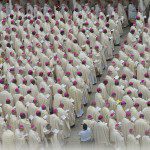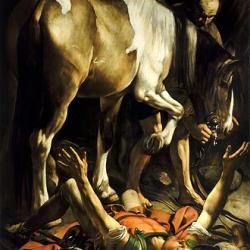
Amid the hustle-and-bustle of checking in, making your way through the obstacle course that is security, and divining where your gate is, you might not have time to grab a bite to eat or sneak in a quick massage, let alone have time to settle yourself for prayer.
But, across the U.S. — and throughout the world — airport chapels, prayer rooms, and interfaith spaces offer travelers an opportunity to do just that: to meditate, catch a few moments of quiet contemplation, or perhaps beseech the travel gods for a bit of mercy when flights are canceled, or luggage lost.
According to sociologist Wendy Cadge, airport chapels had their genesis in the daily devotional needs of Catholic staff working in the airline business. She wrote of how initially, airport chapels “were established by Catholic leaders in the 1950s and 1960s to make sure their parishioners could attend mass.” The very first was Our Lady of the Airways at Boston’s Logan airport, built in 1951.
Today, major transit hubs across the world offer some sort of spiritual respite for the busy traveler.
Pew Research Center found that more than half of the U.S.’s large hub airports (catering to 1% or more of annual air passengers) offer a chapel or interfaith prayer room of some sort. These include standouts like San Diego’s meditation room “The Spirit of Silence,” Orlando’s former, centrally located prayer room, San Juan, Puerto Rico’s decidedly Catholic chapel, or John F. Kennedy Airport’s synagogue, the only one of its kind in the Americas.
Internationally, you can find stunning examples like the Buddhist meditation space at Taiwan’s Taoyuan Airport, Berlin’s Room of Stillness and its formidable fire-brick interior façade, or the new Istanbul airport’s ecologically-certified Ali Kuşçu mosque, which can fit up to 6,230 people for prayer.
Far from cheaply-packaged single-serving spirituality or simply a security threat, airport chapels, prayer rooms, and interfaith spaces offer a chance to reflect on how we define religion, both at home and abroad. Their persistent popularity, and their place in our religious imagination, exhibit the pluralism, plasticity, and politics that typify global religion today.
A shift from single faith to multifaith.
In the U.S., Cadge noted a discrete shift in the 1990s and 2000s, as single-faith chapels became a “dying breed,” replaced by spaces that could welcome people of all religions. She pointed out how San Francisco International Airport’s Berman Reflection Room, “looks like a quiet waiting room filled with plants and lines of connected chairs. A small, enclosed space without any religious symbols or obvious connections to things religious or spiritual is available for services.” Similarly, Atlanta’s airport chapel is stripped of any explicit religious markers, “with only a few chairs and clear glass entrances, to provide space for quiet reflection.”
As Courtney Bender of Columbia University noted, “multi-faith modernist spaces” such as airport chapels “are poised at the nexus of two often countervailing ideals”: a desire to design space that anyone could recognize and experience as “sacred” and to accommodate the multiple and specific bodies, actions, and materials that people using the space require to pray as they know how.
Those that do not represent a particular creed (e.g., Catholic, Jewish, Buddhist, Muslim) try to create pluralistic vibes, typified in the entryways to London Gatwick’s interfaith chapel or Amsterdam Schipol’s, bearing symbols from Sikh, Jewish, Christian, Buddhist, Hindu, Taoist, Shinto, or Islamic traditions.
Others opt for more-or-less neutral spaces, where symbols are fluid, plastic, and not necessarily attributable to any single tradition. Stark symbols of unity, singularity, and natural simplicity replace more ornate or distinct symbology of specific religions. Whether it’s beams of light at Hong Kong’s prayer room, a single, rough-hewn tree in the center of a white box in Munich, or concrete brutalism at Paris Orly, these spaces are malleable and moldable — capable of being shaped into myriad forms by multiple actors, religious and non-religious.
In his photo series “Places of Worship,” artist Andreas Duscha features numerous multifaith spaces at airports across the world. “Particularly when viewed with respect to worldwide religious tensions, they can be considered as representative of a symptomatic phenomenon,” he wrote.
Furthermore, he wondered, “could it be that airports, as centers of high security, are precisely that place where interreligious dialog can be realized? And how is it possible for these ‘spaces of peace’ to exist entirely apart from those hectic streams of movement that so typify airports as sites that exist primarily to be passed through?”
Defining how, and where, we pray.
Indeed, it is perhaps notable to pay attention to where these chapels are located.
As scholars at Indiana University noted, “in an age of frequent flying, airports are sometimes characterized as ‘non-places,’” liminal locations that are neither “here nor there.” And yet, airport chapels and prayer rooms help create a sense of place, or as Jonathan Z. Smith might have put it, “locative and utopian” space.
They can also signal the ways in which national and/or globalizing processes can define, delimit, or transform sacred space and practices.
On the one hand, there is a tendency for chapels and prayer rooms to take on ever more fluid, pluralistic, and “interfaith” character to meet the functional and aesthetic needs of people from various religious perspectives.On the other hand, there are certain locales where only one religion is explicitly catered to, or one tradition given primacy in terms of space, symbols, or use.
Both reflect the politics of religion in that given place and what those behind the airport’s construction — or the chaplains that are responsible for that airport’s spiritual services — define proper “religion” to be.
Perhaps airport chapels are not the harbingers of a peaceful, interfaith future that we might hope or assume. Like the airports they are housed in, they are built for particular purposes and constructed with a sense of creating and claiming, marking and maintaining sacred space.
In this way, they are like other religious projects, practices, and places in that they are not necessarily sacred or set apart from human activity, but explicitly defined by it.
Airport chapels, in the end, become another example of how we try to define religion and seek to govern others and marginalize or manage expressions thereof. This is the case whether the chapel is explicitly Catholic or Muslim or if it is decidedly devoid of specific symbols and labeled “interfaith.”
In the end, both are attempts by authorities to dictate the structures that regulate religious practice, whether that practice be singular or decidedly pluralistic or if only for individuals in transit between here and there, home and far away.
7/15/2022 5:10:14 PM





